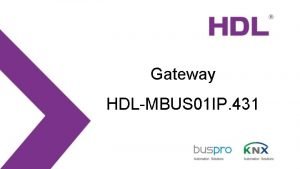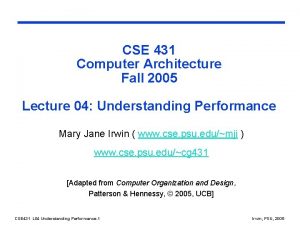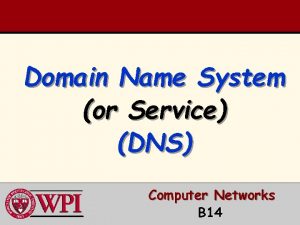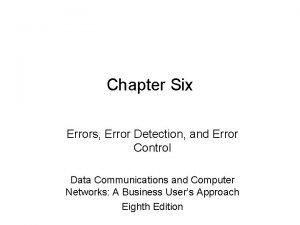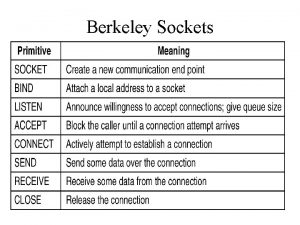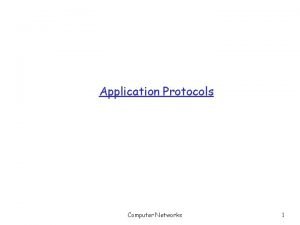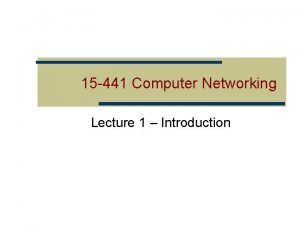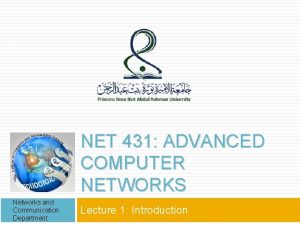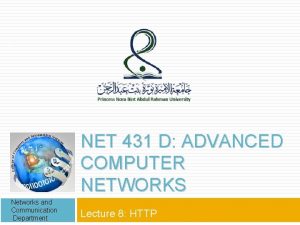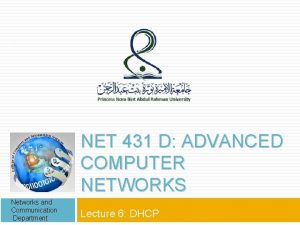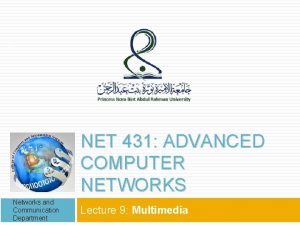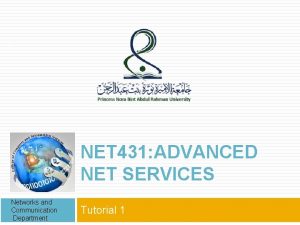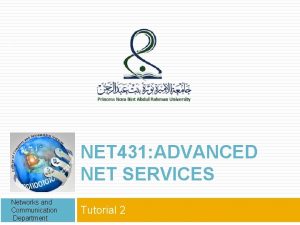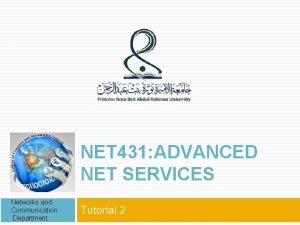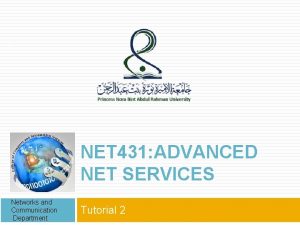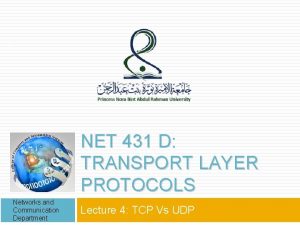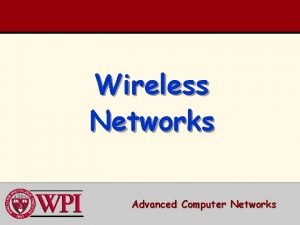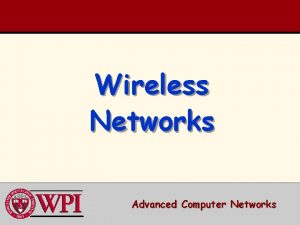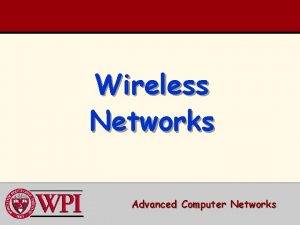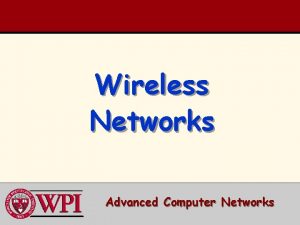1 NET 431 D ADVANCED COMPUTER NETWORKS Networks


























































- Slides: 58

1 NET 431 D: ADVANCED COMPUTER NETWORKS Networks and Communication Department Lecture 5: IPV 6 part 1: Addressing

Outlines � � Part 1: Introduction IPv 4 and IPv 6 Coexistence IPv 6 Network Addresses Part 2: IPv 6 Packet format Part 3: IPv 6 Security

3 Part 1: IP Addressing 05 -Mar-21 Networks and Communication Department

IP 4 The Internet Protocol (IP) has been the foundation of the Internet and virtually all multivendor private internetworks. This IP 4 protocol is reaching the end of its useful life, and a new protocol, known as IPv 6 (IP version 6), has been defined to ultimately replace IP 4 05 -Mar-21 Networks and Communication Department

ICMPv 4 and ICMPv 6 Messages ICMP messages common to both ICMPv 4 and ICMPv 6 include: § § § Host confirmation Destination or Service Unreachable Time exceeded Route redirection Although IP is not a reliable protocol, the TCP/IP suite does provide for messages to be sent in the event of certain errors, sent using the services of ICMP.

6 Motivation for developing a new version of IP 1. The driving motivation for the adoption of a new version of IP was the limitation imposed by the 32 bit address field in IPv 4. With a 32 -bit address field, it is possible in principle to assign different addresses, which is over 4 billion possible addresses. One might think that this number of addresses was more than adequate to meet addressing needs on the Internet. However, in the late 1980 s it was perceived that there would be a problem, and this problem began to manifest itself in the early 1990 s. 05 -Mar-21 Networks and Communication Department

7 Reasons for the inadequacy of 32 -bit addresses include the following: The two-level structure of the IP address (network number, host number) is convenient but wasteful of the address space Once a network number is assigned to a network, all of the host-number addresses for that network number are assigned to that network. The address space for that network may be sparsely used, but as far as the effective IP address space is concerned, if a network number is used, then all addresses within the network are 05 -Mar-21 Networks and Communication Department used.

8 6. The IP addressing model generally requires that a unique network number be assigned to each IP network whether or not it is actually connected to the Internet. 7. Networks are proliferating rapidly. Most organizations boast multiple LANs, not just a single LAN system. 8. Growth of TCP/IP usage into new areas will result in a rapid growth in the demand for unique IP addresses. Examples include using TCP/IP to interconnect electronic point-of-sale terminals and 05 -Mar-21 Networks and Communication Department for cable television receivers.

9 8. Typically, a single IP address is assigned to each host. A more flexible arrangement is to allow multiple IP addresses per host. This, of course, increases the demand for IP addresses. 9. So the need for an increased address space dictated that a new version of IP was needed. In addition, IP is a very old protocol, and new requirements in the areas of address configuration, routing flexibility, and traffic support had been defined. 05 -Mar-21 Networks and Communication Department

10 IPv 6 includes the following enhancements over IPv 4 Expanded address space: IPv 6 uses 128 -bit addresses instead of the 32 -bit addresses of IPv 4. This is an increase of address space. It has been pointed out that this allows on the order of unique addresses per square meter of the surface of the earth. Even if addresses are very inefficiently allocated, this address space seems inexhaustible. Improved option mechanism: IPv 6 options are placed in separate optional headers that are located between the IPv 6 header and the transport-layer header. Most of these optional headers are not examined or processed by any router on the packet’s path. This simplifies and speeds up router processing of IPv 6 packets compared to IPv 4 datagrams. 05 -Mar-21 Networks and Communication Department

11 Address autoconfiguration: This capability provides for dynamic assignment of IPv 6 addresses. Increased addressing flexibility: IPv 6 includes the concept of an any cast address, for which a packet is delivered to just one of a set of nodes. The scalability of multicast routing is improved by adding a scope field to multicast addresses. 05 -Mar-21 Networks and Communication Department

12 Support for resource allocation: IPv 6 enables the labeling of packets belonging to a particular traffic flow for which the sender requests special handling. This aids in the support of specialized traffic such as real-time video. 05 -Mar-21 Networks and Communication Department

IPv 4 Issues IPv 4 and IPv 6 Coexistence The migration techniques can be divided into three categories: Dual-stack, Tunnelling, and Translation. Dual-stack: Allows IPv 4 and IPv 6 to coexist on the same network. Devices run both IPv 4 and IPv 6 protocol stacks simultaneously.

IPv 4 Issues IPv 4 and IPv 6 Coexistence (cont. ) Tunnelling: A method of transporting an IPv 6 packet over an IPv 4 network. The IPv 6 packet is encapsulated inside an IPv 4 packet.

IPv 4 Issues IPv 4 and IPv 6 Coexistence (cont. ) Translation: The Network Address Translation 64 (NAT 64) allows IPv 6 -enabled devices to communicate with IPv 4 -enabled devices using a translation technique similar to NAT for IPv 4. An IPv 6 packet is translated to an IPv 4 packet, and vice versa.

IPv 6 Addressing IPv 6 Address Representation 128 bits in length and written as a string of hexadecimal values In IPv 6, 4 bits represents a single hexadecimal digit, 32 hexadecimal value = IPv 6 address � 2001: 0 DB 8: 0000: 1111: 0000: 0200 � FE 80: 0000: 0123: 4567: 89 AB: CDEF Hextet used to refer to a segment of 16 bits or four hexadecimals Can be written in either lowercase or uppercase

IPv 6 Addressing Rule 1 - Omitting Leading 0 s The first rule to help reduce the notation of IPv 6 addresses is any leading 0 s (zeros) in any 16 -bit section or hextet can be omitted. 01 AB can be represented as 1 AB. 09 F 0 can be represented as 9 F 0. 0 A 00 can be represented as A 00. 00 AB can be represented as AB.

IPv 6 Addressing Rule 2 - Omitting All 0 Segments A double colon (: : ) can replace any single, contiguous string of one or more 16 -bit segments (hextets) consisting of all 0’s. Double colon (: : ) can only be used once within an address otherwise the address will be ambiguous. Known as the compressed format. Incorrect address - 2001: 0 DB 8: : ABCD: : 1234.

IPv 6 Addressing Rule 2 - Omitting All 0 Segments (cont. ) Example #1 Example #2

Types of IPv 6 Addresses IPv 6 Prefix Length IPv 6 does not use the dotted-decimal subnet mask notation Prefix length indicates the network portion of an IPv 6 address using the following format: § § § IPv 6 address/prefix length Prefix length can range from 0 to 128 Typical prefix length is /64

Types of IPv 6 Addresses IPv 6 Address Types There are three types of IPv 6 addresses: § Unicast § § Multicast Anycast. Note: IPv 6 does not have broadcast addresses.

Types of IPv 6 Addresses IPv 6 Unicast Addresses Unicast § § Uniquely identifies an interface on an IPv 6 -enabled device. A packet sent to a unicast address is received by the interface that is assigned that address.

Types of IPv 6 Addresses IPv 6 Link-Local Unicast Addresses Every IPv 6 -enabled network interface is REQUIRED to have a linklocal address Enables a device to communicate with other IPv 6 -enabled devices on the same link and only on that link (subnet) FE 80: : /10 range, first 10 bits are 1111 1110 10 xx xxxx 1111 1110 1000 0000 (FE 80) - 1111 1110 1011 1111 (FEBF)

IPv 6 Unicast Addresses Static Configuration of an IPv 6 Global Unicast Address (cont. ) Windows IPv 6 Setup

25 Part 2: IPv 6 Packet format 05 -Mar-21 Networks and Communication Department

26 IPv 6 protocol data unit (known as a packet) The only header that is required is referred to simply as the IPv 6 header. This is of fixed size with a length of 40 octets, compared to 20 octets for the IPv 4 header. The following extension headers have been defined: � � � Hop-by-Hop Options header: Defines special options that require hopby-hop processing Routing header: Provides extended routing, similar to IPv 4 source routing Fragment header: Contains fragmentation and reassembly information Authentication header: Provides packet integrity and authentication Encapsulating Security Payload header: Provides privacy Destination Options header: Contains optional information to be examined by the destination node 05 -Mar-21 Networks and Communication Department

27 The IPv 6 standard recommends that, when multiple extension headers are used, the IPv 6 headers appear in the following order: 1. IPv 6 header: Mandatory, must always appear first 2. Hop-by-Hop Options header 3. Destination Options header: For options to be processed by the first destination that appears in the IPv 6 Destination Address field plus subsequent destinations listed in the Routing header 4. Routing header 5. Fragment header 6. Authentication header 7. Encapsulating Security Payload header 8. Destination Options header: For options to be processed only by the final destination of the packet 05 -Mar-21 Networks and Communication Department

28 IPv 6 Packet with Extension Headers (containing a TCP Segment) Note that the IPv 6 header and each extension header include a Next Header field. This field identifies the type of the immediately following header. If the next header is an extension header, then this field contains the type identifier of that header. Otherwise, this field contains the protocol identifier of the upper-layer protocol using IPv 6 (typically a transport-level protocol), using the same values as the IPv 4 Protocol field. 05 -Mar-21 Networks and Communication Department

IPv 6 Header 29 05 -Mar-21 Networks and Communication Department

IPv 6 Header 30 Version (4 bits): Internet protocol version number; the value is 6. DS/ECN (8 bits): Available for use by source nodes and/or routers for differentiated services and congestion functions, as described for the IPv 4 DS/ECN field. Flow Label (20 bits): May be used by a host to label those packets for which it is requesting special handling by routers within a network. Payload Length (16 bits): Length of the remainder of the IPv 6 packet following the header, in octets. In other words, this is the total length of all of the extension headers plus the transport-level PDU. Next Header (8 bits): Identifies the type of header immediately following the IPv 6 header; this will either be an IPv 6 extension header or a higher-layer header, such as TCP or UDP. 05 -Mar-21 Networks and Communication Department

IPv 6 Header 31 Hop Limit (8 bits): The remaining number of allowable hops for this packet. The hop limit is set to some desired maximum value by the source and decremented by 1 by each node that forwards the packet. The packet is discarded if Hop Limit is decremented to zero. Source Address (128 bits): The address of the originator of the packet. Destination Address (128 bits): The address of the intended recipient of the packet. This may not in fact be the intended ultimate destination if a Routing header is present, as explained 05 -Mar-21 Networks and Communication Department subsequently.

IPv 6 Header 32 Although the IPv 6 header is longer than the mandatory portion of the IPv 4 header (40 octets versus 20 octets), it contains fewer fields (8 versus 12). Thus, routers have less processing to do per header, which should speed up routing. 05 -Mar-21 Networks and Communication Department

Flow Label 33 flow as a sequence of packets sent from a particular source to a particular (unicast, anycast, or multicast) destination for which the source desires special handling by the intervening routers. A flow is uniquely identified by the combination of a source address, destination address, and a nonzero 20 -bit flow label. Thus, all packets that are to be part of the same flow are assigned the same flow label by the source. From the source’s point of view, a flow typically will be a sequence of packets that are generated from a single application instance at the source and that have the same transfer service requirements. 05 -Mar-21 Networks and Communication Department

Flow Label 34 From the router’s point of view, a flow is a sequence of packets that share attributes that affect how these packets are handled by the router. These include path, resource allocation, discard requirements, accounting, and security attributes. The router may treat packets from different flows differently in a number of ways, including allocating different buffer sizes, giving different precedence in terms of forwarding, and requesting different quality of service from networks. 05 -Mar-21 Networks and Communication Department

Flow Label 35 The following rules apply to the flow label: � 1. Hosts or routers that do not support the Flow Label field must: set the field to zero when originating a packet, pass the field unchanged when forwarding a packet, and ignore the field when receiving a packet. � 2. All packets originating from a given source with the same nonzero Flow Label must have the same Destination Address, Source Address, Hopby-Hop Options header contents, and Routing header contents (if this header is present). 05 -Mar-21 Networks and Communication Department

Flow Label 36 � 3. The source assigns a flow label to a flow. New flow labels must be chosen (pseudo-) randomly and uniformly in the range 1 to subject to the restriction that a source must not reuse a flow label for a new flow within the lifetime of the existing flow. Note: The zero flow label is reserved to indicate that no flow label is being used. 05 -Mar-21 Networks and Communication Department

Home Work! 37 Search about how router maintains information about the characteristics of each active flow that may pass through it. 05 -Mar-21 Networks and Communication Department

38 Part 3: VIRTUAL PRIVATE NETWORKS AND IP SECURITY 05 -Mar-21 Networks and Communication Department

VPN 39 In today’s distributed computing environment, the virtual private network (VPN) offers an attractive solution to network managers. In essence, a VPN consists of a set of computers that interconnect by means of a relatively unsecure network and that make use of encryption and special protocols to provide security 05 -Mar-21 Networks and Communication Department

40 05 -Mar-21 Networks and Communication Department

Distributed system 41 At each corporate site, workstations, servers, and databases are linked by one or more local area networks (LANs). The LANs are under the control of the network manager and can be configured and tuned for cost-effective performance. The Internet or some other public network can be used to interconnect sites, providing a cost savings over the use of a private network and offloading the wide area network management task to the public network provider. That same public network provides an access path for telecommuters and other mobile employees to log on to corporate systems from remote sites. 05 -Mar-21 Networks and Communication Department

Security 42 But the manager faces a fundamental requirement: security. Use of a public network exposes corporate traffic to eavesdropping and provides an entry point for unauthorized users. To counter this problem, the manager may choose from a variety of encryption and authentication packages and products. Proprietary solutions raise a number of problems. � First, how secure is the solution? If proprietary encryption or authentication schemes are used, there may be little reassurance in the technical literature as to the level of security provided. � Second is the question of compatibility. No manager wants to be limited in the choice of workstations, servers, routers, firewalls, and so on by a need for compatibility with the security facility. 05 -Mar-21 � This Department is the motivation for the IP Security. Networks (IPSec)and set. Communication of Internet standards.

IPSec 43 In 1994, the Internet Architecture Board (IAB) issued a report titled “Security in the Internet Architecture” (RFC 1636). The report stated the general consensus that the Internet needs more and better security and identified key areas for security mechanisms. Among these were the need to secure the network infrastructure from unauthorized monitoring and control of network traffic and the need to secure end-user- to-end-user traffic using authentication and encryption mechanisms. 05 -Mar-21 Networks and Communication Department

IPSec 44 To provide security, the IAB included authentication and encryption as necessary security features in the next-generation IP, which has been issued as IPv 6. Fortunately, these security capabilities were designed to be usable both with the current IPv 4 and the future IPv 6. This means that vendors can begin offering these features now, and many vendors do now have some IPSec capability in their products. The IPSec specification now exists as a set of Internet standards. 05 -Mar-21 Networks and Communication Department

Applications of IPSec 45 IPSec provides the capability to secure communications across a LAN, across private and public WANs, and across the Internet. Examples of its use include the following: 05 -Mar-21 Networks and Communication Department

Applications of IPSec 46 Secure branch office connectivity over the Internet: A company can build a secure virtual private network over the Internet or over a public WAN. This enables a business to rely heavily on the Internet and reduce its need for private networks, saving costs and network management overhead. Secure remote access over the Internet: An end user whose system is equipped with IP security protocols can make a local call to an Internet service provider (ISP) and gain secure access to a company network. This reduces the cost of toll charges for traveling employees and telecommuters. 05 -Mar-21 Networks and Communication Department

Secure branch office connectivity over the Internet § Information from a private network is securely transported over a public network. § Forms a virtual network instead of using a dedicated Layer 2 connection. § To remain private, the traffic is encrypted to keep the data confidential.

Applications of IPSec 48 Establishing extranet and intranet connectivity with partners: IPSec can be used to secure communication with other organizations, ensuring authentication and confidentiality and providing a key exchange mechanism. Enhancing electronic commerce security: Even though some Web and electronic commerce applications have built-in security protocols, the use of IPSec enhances that 05 -Mar-21 Networks and Communication Department security.

49 The principal feature of IPSec that enables it to support these varied applications is that it can encrypt and/or authenticate all traffic at the IP level. Thus, all distributed applications, including remote logon, client/server, e-mail, file transfer, Web access, and so on, can be secured. 05 -Mar-21 Networks and Communication Department

50 Example: A typical scenario of IPSec usage 05 -Mar-21 Networks and Communication Department

Home Work! 51 Mention some of the benefits of IPSec. 05 -Mar-21 Networks and Communication Department

IPSec Functions 52 IPSec provides three main facilities: � an authentication-only function referred to as Authentication Header (AH), � a combined authentication/encryption function called Encapsulating Security Payload (ESP), � and a key exchange function. 05 -Mar-21 Networks and Communication Department

53 For VPNs, both authentication and encryption are generally desired, because it is important both to � (1) assure that unauthorized users do not penetrate the virtual private network � and (2) assure that eavesdroppers on the Internet cannot read messages sent over the virtual private network. Because both features are generally desirable, most implementations are likely to use ESP rather than AH. The key exchange function allows for manual 05 -Mar-21 Networks and Communication Department exchange of keys as well as an automated scheme.

IPsec Framework Confidentiality with Encryption § For encryption to work, both the sender and the receiver must know the rules used to transform the original message into its coded form. § Rules are based on algorithms and associated keys. § Decryption is extremely difficult (or impossible) without the correct key.

IPsec Framework Encryption Algorithms § As key length increases, it becomes more difficult to break the encryption. However, a longer key requires more processor resources when encrypting and decrypting data. § Two main types of encryption are: § Symmetric Encryption § Asymmetric Encryption

IPsec Framework Symmetric Encryption § Encryption and decryption use the same key. § Each of the two networking devices must know the key to decode the information. § Each device encrypts the information before sending it over the network to the other device. § Typically used to encrypt the content of the message.

IPsec Framework Asymmetric Encryption § Uses different keys for encryption and decryption. § Knowing one of the keys does not allow a hacker to deduce the second key and decode the information. § One key encrypts the message, while a second key decrypts the message. § Public key encryption is a variant of asymmetric encryption that uses a combination of a private key and a public key. § Typically used in digital certification and key management

58 Q&A Thank You 05 -Mar-21 Networks and Communication Department
 Virtual circuit network and datagram network
Virtual circuit network and datagram network Basestore iptv
Basestore iptv Bio 431
Bio 431 Me 431
Me 431 Hdl-mbus01ip.431
Hdl-mbus01ip.431 Eee 431
Eee 431 Eee 431
Eee 431 Eee 431
Eee 431 Eee 431
Eee 431 Eee 431
Eee 431 Eee 431
Eee 431 Eee 431
Eee 431 Cs 431
Cs 431 431 bce
431 bce Ds 431
Ds 431 Cse 431
Cse 431 Cse 431
Cse 431 431 bc
431 bc Fundamentals of cpu in advanced computer architecture
Fundamentals of cpu in advanced computer architecture Advanced topics in computer science
Advanced topics in computer science Advanced computer graphics
Advanced computer graphics Advanced computer forensics
Advanced computer forensics Fastbloc se
Fastbloc se Crc in computer networks
Crc in computer networks Crc in computer networks
Crc in computer networks Traffic management in computer networks
Traffic management in computer networks Tpdu in computer networks
Tpdu in computer networks What is optimality principle in computer networks
What is optimality principle in computer networks Snmp model in computer networks
Snmp model in computer networks What is optimality principle in computer networks
What is optimality principle in computer networks Applications of computer networks
Applications of computer networks Classify computer networks based on transmission technology
Classify computer networks based on transmission technology Intro dns
Intro dns Intserv vs diffserv
Intserv vs diffserv Icmp in computer networks
Icmp in computer networks Http computer networks
Http computer networks Framing in computer network
Framing in computer network Dns in computer networks
Dns in computer networks Computer networks assignment
Computer networks assignment Network vs distributed system
Network vs distributed system Badrinath
Badrinath Error correction techniques in computer networks
Error correction techniques in computer networks Error detection in computer networks
Error detection in computer networks Internet transport protocol in computer networks
Internet transport protocol in computer networks Error control in computer networks
Error control in computer networks Subnet
Subnet Data link layer switching in computer networks
Data link layer switching in computer networks Layered tasks
Layered tasks Bit stuffing and byte stuffing difference
Bit stuffing and byte stuffing difference Bit stuffing and byte stuffing in computer networks
Bit stuffing and byte stuffing in computer networks Byte stuffing
Byte stuffing Berkley sockets
Berkley sockets What is the reverse request protocol?
What is the reverse request protocol? In ftp protocol client contacts server using
In ftp protocol client contacts server using Principles of network applications
Principles of network applications Switching techniques in computer networks
Switching techniques in computer networks 15-441
15-441 A utopian simplex protocol
A utopian simplex protocol Sonet architecture
Sonet architecture




